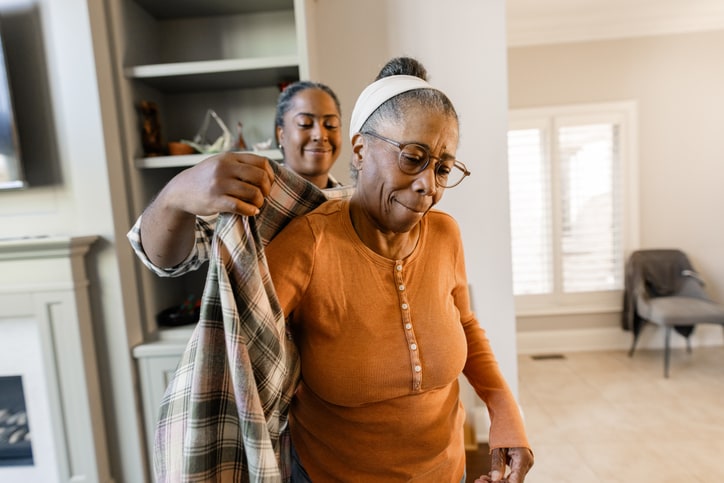In this article
While assisted living facilities can help older individuals carry out daily activities like bathing, preparing meals and housekeeping, dementia is a progressive cognitive condition. At some point, their needs will extend beyond what those organizations can provide, says Amy Cameron O’Rourke, a dedicated care manager and author of “The Fragile Years.” That’s where established memory care facilities come into play, she notes. A skilled memory unit will be equipped with staff who understand the ins and outs of dementia and can provide an environment that ensures a resident’s safety, well-being and overall happiness, she explains.
How do you know when that threshold has been crossed, and it’s time to transition a loved one with dementia from assisted living to an out-of-home memory care facility? Here, experts outline the signs and how to make the transition as seamless (and safe) as possible.
Key takeaways
- Though assisted living facilities can help older individuals with general daily activities, if that person has dementia, they may require more specialized care from a memory care unit.
- By keeping communication lines open and being transparent and upfront with your loved one (and family members), you can help make the transition to a memory care facility much smoother.
- The transition to memory care can be emotionally taxing on the caregiver themselves, so it’s important to recognize your own needs along the way.
How to recognize the need for a memory care unit
Dementia is a condition that gets more severe over time, and its early signs can be subtle. Perhaps a loved one with the disease shows signs of mild forgetfulness early on — say, they misplace their keys or forget a doctor’s appointment. At this stage, an individual can most likely comfortably (and safely) live in an assisted living facility, says Kyle Bossung, president and CEO of Senior1Care in Mishawaka, Indiana.
“In the early stages of dementia, assisted living can meet a person’s needs by helping with meals, medications and light support,” he explains. “But as dementia progresses, the level of care often increases. Behaviors like wandering and agitation can stretch beyond what assisted living communities are able to manage.”
At this point, Bossung notes, ensuring a loved one is under proper memory care — either via in-home care or out-of-home care — can be helpful. “The earlier families can identify these changes, the more options they’ll have,” he explains. “Being proactive reduces the chance of a crisis.” A few early signs of dementia:
- Difficulty with normal tasks. This might include something as simple as driving to a familiar location, losing items, or not keeping up with their appearance.
- Confusion with time and place. Perhaps a loved one loses track of dates.
- Changes in communication. A person with dementia may repeat themselves or lose track of their place in a conversation, or they might start withdrawing from social interactions entirely.
If a loved one has been diagnosed with dementia, or they’re at-risk for it (say, it runs in the family), it might be worth coming up with a dementia care plan. (Here’s how to hire an in-home memory caregiver if you’d rather have private care.)
Key indicators it’s time to move to memory care
Just because a person is showing early signs of dementia doesn’t mean you need to rush them to a memory care facility. As Ron Schulman, owner of SYNERGY HomeCare of Columbus, Ohio, notes, that might make things worse. “The more time people can feel a sense of independence and be safe and healthy, the better,” he explains. “Rushing to memory care, in my view and experience, only accelerates the cognitive decline.” That’s because, as Schulman says, the transition to memory care is a major environmental change for a person. The longer people have a semblance of independence and can carry out their lives as normally as possible, the better. “Memory care should be reserved for those whose cognition has gotten to the point where there’s no other return,” he adds.
That said, as dementia escalates, there will come a point when it will be necessary to move to memory care for a loved one’s safety and well-being. Here are a handful of key indicators:
Behavioral changes
Increased confusion or disorientation.
O’Rourke says that she often sees clients in assisted living facilities (on the brink of being moved to out-of-home memory care) who are frequently confused or even hallucinate. “I’ve had clients who will call their family member 20 times per day asking to bring them home,” she notes. “Perhaps they see something, or someone, that isn’t there, a person coming into their room or a burglar.”
Aggressive or agitated behaviors.
As Schulman explains, major behavioral or mood changes can be a sign that an individual might benefit from memory care. He says that this might include small issues getting blown out of proportion or increased agitation with other residents or staff in an assisted living facility.
Safety concerns
Wandering or getting lost
“I’ve had clients [in assisted living] wander into other people’s rooms thinking it’s their own, or they get into somebody else’s bed,” O’Rourke explains. Schulman adds that, while wandering off might seem inconsequential, it’s often a tipoff for when the disease presents a safety issue. “This is very dangerous and a clear sign a secured unit is where they need to be for their own safety and the safety of others,” he explains.
Frequent falls or unexplained injuries
As Bossung explains, when a person starts to show unexplained bruises or other strange injuries, it could mean that a) they’re inadvertently hurting themselves and forgetting about it, or b) they’re wandering into dangerous situations without fully understanding what’s going on.
Decline in daily functioning
Neglecting personal hygiene
“When residents seem to ignore personal hygiene, bathing, oral care, or even combing their hair, that can be a sign they are just forgetting to do these things,” Schulman notes.
Difficulty with medication management
O’Rourke says that either a refusal to take certain medications, or just omitting them out of forgetfulness, is a safety issue and a sign that a memory care facility might be ideal.
Weight loss
For Schulman, this was a major indicator that his mother, who has Alzheimer’s disease, was ready for a memory care facility. “It was not until we increased her care, so every meal was covered, did we stop her weight loss,” he says.
Social withdrawal
Avoiding social interactions or loss of interest in previously enjoyed activities
A person disengaging with friends, family and community in general is often a sign of dementia at a later stage.
Medical recommendations
The work has become too much for an in-home memory caregiver
“When caregivers feel overwhelmed, burned out, or unable to provide 24/7 supervision for someone with dementia, it may also be a sign that professional memory care is needed,” explains Lauren B. Parker, owner of NDO Wellness and a Henderson, Nevada-based nurse practitioner with decades of experience working in memory care facilities.
A loved one’s physician has advised that out-of-home memory care might be beneficial.
Of course, as the experts interviewed for this piece agreed, if staff at the assisted living facility (or your loved one’s primary care doctor) believe they might benefit from out-of-home memory care, you should listen. They may have witnessed certain red flags you haven’t, given their 24/7 proximity to your loved one.
“The more time people can feel a sense of independence and be safe and healthy, the better. Rushing to memory care, in my view and experience, only accelerates the cognitive decline.”
— Ron Schulman, home care agency owner
The benefits of memory care communities
If your loved one has started showing any of the aforementioned signs — or they’ve been diagnosed with Alzheimer’s or dementia, and you’re concerned for them in any regard — a memory care facility can be hugely beneficial. “These environments are built specifically for individuals living with dementia, offering structured routines, trained staff and safety features that support both quality of life and peace of mind for families,” Parker explains. Here are a handful of benefits that an out-of-home memory care community provides.
Specialized care
“If a loved one can no longer follow daily routines, struggles with personal safety, or needs frequent redirection, memory care offers a higher level of care and emotional stability that traditional assisted living cannot provide,” Parker says.
Enhanced safety measures
As Parker notes, memory care facilities will typically provide 24/7 supervision and secured entrances so patients don’t wander off the premises (and potentially into danger).
Therapeutic activities
O’Rourke notes that there are both good and bad memory care facilities (more on that below!), and that “locking the doors,” per se, is the bare minimum. She says a good memory care facility will provide a trove of engaging activities for residents, from classes and workshops to specialized therapy.
Support for families
As O’Rourke also adds, a quality memory care unit will be in constant contact with families, providing regular updates and keeping loved ones on top of any changes in a loved one’s health and behavior.
Tips to prepare for the transition from assisted living to memory care
When O’Rourke received a phone call from her father in an assisted living facility one early morning, she knew something was off. “He called me at 5 in the morning asking why I wasn’t there to pick him up,” she recalls. “I told him I was to pick him up at 5 that evening.” O’Rourke had an inkling as to what was happening: Her father was showing early signs of dementia.
Someone with Alzheimer’s or dementia, like O’Rourke’s father, is already prone to confusion and agitation in many cases, so it’s important to tread carefully and respectfully when the transition period from assisted living to memory care comes. “A well-thought-out approach helps reduce emotional distress, making the change feel less like a loss, which is common with any major change,” Parker notes. Here are some tips on gearing up for the transition from assisted living to memory care.
Keep communication open
Make sure other family members are in the loop
As O’Rourke reiterates, your care for a loved one doesn’t end the moment they walk into a memory care facility. Rather, it will be imperative that you and any close family members are prepared for the transition and how that may impact your loved one, and any family dynamics.
Involve your loved one with dementia in decision-making when possible
“Preparing a loved one for the move to memory care starts with early, honest and compassionate conversations,” Parker emphasizes. “Involving the loved one as much as possible in discussions, while being mindful of their cognitive state, is important and maintains their dignity.”
Plan to research and visit many facilities
Tour potential memory care communities
“Touring facilities, when appropriate, can help reduce fear and build familiarity while laying the foundation for a smoother transition,” Parker notes.
Assess the environment and staff interactions
As you look at potential facilities, O’Rourke says it’s important to assess details like their security protocols, but she says that programming activities are the major things to look for, and whether they have ones that cater to mild, moderate and severe stages of dementia. “Do they have one-on-one counseling and large groups?” she notes. “Trained professionals who design and implement a program that’s appropriate for various stages of a memory impairment is the biggest thing I look for.” Here are some other key things to look for in a memory care facility.
Factor in the finances of the transition
Figure out what you can afford as a family and explore payment options
“Financial preparation is important, as you want to ensure you have considered all payment options and are aware of all long-term care benefits,” Parker explains. The National Council on Aging notes that memory care services often cost about $6,160 monthly, or nearly $74,000 annually. Use our senior care cost calculator to estimate monthly costs in your area.
Review insurance options or any benefits you might have
Here are a handful of ideas to help pay for long-term memory care.
How to support your loved one through the transition to memory care
Transitioning a loved one from an assisted living facility to out-of-home memory care is a process, and no two families will share the same journey. “There’s an [elder care] industry phrase that says, ‘If you’ve seen one person with a memory impairment, you’ve seen one person with a memory impairment,’” O’Rourke says. Basically, she reiterates, how a loved one responds to the transition will vary wildly, and it’s important to stay nimble and reassuring as their support system through the process. Here are a few tips on making the transition a bit smoother:
Help your older loved one personalize their new space to their liking
As Parker notes, any attempt to combine a loved one’s identity with their new space can sometimes help make a new space seem more familiar. “Families can provide personal items like favorite photos, blankets, music or books, which provide a sense of home in the new space,” she explains.
Aim for regular visits, but don’t wear your welcome
As O’Rourke explains, many memory care facilities will ask that family members do not visit their loved one for the first few weeks — a practice she doesn’t necessarily agree with.
“Short, frequent visits can be comforting,” Parker adds. “Whether through visits, phone calls or letters, the consistent family support provides reassurance and reminds them they are not alone and still deeply loved.”
Just be wary of overstaying your welcome, she says. “Staying too long or visiting too often, in the beginning, can sometimes increase anxiety and emotional distress,” Parker notes.
Monitor their adjustment with the staff
Be sure to share your loved one’s dislikes, likes, medication, other conditions, as well as general daily habits with the staff, says Parker. “Working closely with the staff is paramount,” she notes. “They are instrumental in easing the transition for all involved by providing updates on how your loved one is adjusting.”
What to know moving forward
Moving a loved one from an assisted living facility into memory care is a major life transition. But it’s important to remember that your loved one isn’t the only person being affected. “In my 40 years [in my career], moving someone into memory care has been the hardest thing to do, especially with a spouse or a child,” O’Rourke notes. “For me personally, it was harder than losing someone to death.”
That said, O’Rourke encourages caregivers and loved ones of individuals with dementia to seek out support from folks in similar situations. Perhaps you can exchange numbers with another family member with someone in the memory care unit, or join a support group. Seeking emotional support from a therapist or counselor is also a good idea, she notes.
Always remember that the decision to move a family member to memory care, while difficult, was made in their best interest. Continue regular check-ins and visits with your loved one to show your support, and lean on the memory care staff when you need it. As Parker concludes, “Whether through visits, phone calls or letters, consistent family support provides reassurance and reminds them they are not alone and still deeply loved.”





